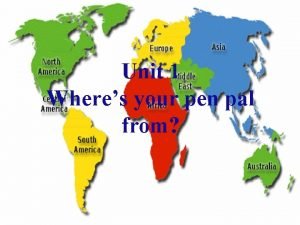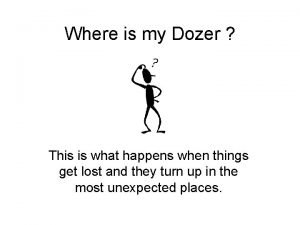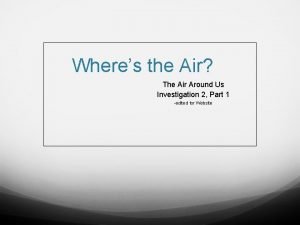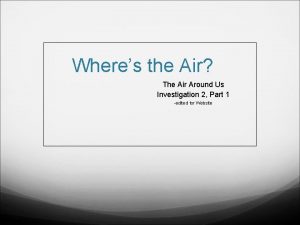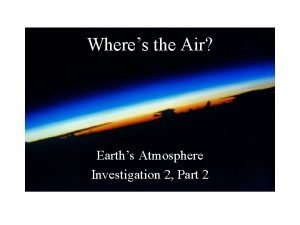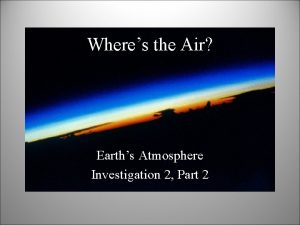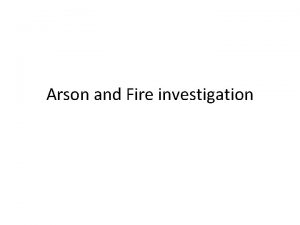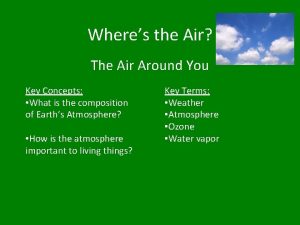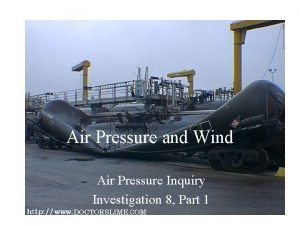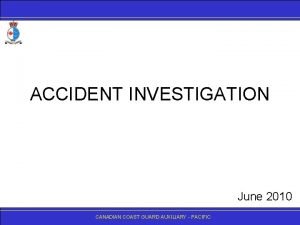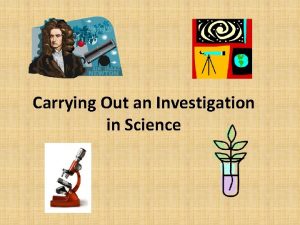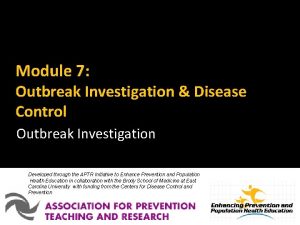Wheres the Air Investigation 2 Wheres the Air
































- Slides: 32

Where’s the Air?

Investigation 2 - Where’s the Air? • Enduring Understanding: • Weather occurs in the atmosphere and the atmosphere is composed of air, which has mass and can be compressed. • Learning Goals: • I will conduct experiments to determine that air has mass. • I will use a molecular model to compare gas at standard pressure and a gas under increased pressure. • I will explain how experimental results provide evidence that air has mass.

Quick Write • Where does weather happen? –ATMOSPHERE

AIR • In our first investigation we used a variety of weather tools to measure weather conditions. Air plays a very important role in the weather. In the next few days we are going to look more closely at air to learn some of its properties.

SYRINGE • This is a syringe. You can use it to investigate air. You can work with your syringe alone or with other students, but you should not use the syringe to annoy another student!

SYRINGE • Things that annoy other students: –Blowing the syringe in their face –Taking someone elses syringe without asking

MATERIALS • You have the following materials –Syringe –Tubing –Binder clip

SYRINGE • See if you can answer these questions: –What happens to the air in the syringe when you push and pull on the plunger? –What can air do?

3 3 Example: When you push the plunger down, the air in the syringe is pushed out the tube. Example: Does air have weight?

Air Observations • When you clamp the tube closed and push the plunger down, what happens to the air? –The air is pushed into a smaller space. • Is there more air, less air, or the same amount of air in the syringe when the air is pushed into a smaller space? –Same amount

Air Observations • What happens when you let go of the plunger after pushing down? –The air pushes the plunger back up. • What do you think happens to the air when it is pushed into a smaller space? • What happens to push the plunger back out when you release the pressure on the plunger?

COMPRESSION • When you push on the plunger, the air is forced into a smaller space. We say the air is compressed. The same amount of air is still in the syringe when it is compressed.

PRESSURE • Compressed air pushes back with a force equal to the force compressing it. If the force on the plunger is released, the pressure in the compressed air will push the plunger out. The compressed air pushes back, and the push is called pressure!

GAS IN A SYRINGE

AIR • Everything is made out of atoms and molecules, including air. The molecules in gases are free to move around throughout the volume of gas. There is a lot of space between the molecules in gases.

AIR • When a volume of gas is compressed into a smaller space, the molecules are pushed closer together. The number of molecules is the same; they are just closer together.


AIR • Molecules compressed into a smaller space bump into one another more often, and this creates pressure. Pressure pushes in all directions, and if the force keeping the gas compressed is reduced, the gas will expand into a larger space and the molecules will get farther apart.

WORD BANK • Compression- When air is forced into a smaller space. • Pressure- compressed molecules pushing back with a force equal to the force that compressed it.

Let’s review our questions 3 Example: Does air have weight?

From Yesterday • True or False: The syringe on the left has more air than the syringe on the right. Explain.

Where’s the Air?

Questions • Does air have weight (mass)? • Where does air pressure come from? • How does air push the syringe plunger out? • Why is air pressure so strong?

Questions • Does air have weight (mass)? – Balloon Clip

Does air have mass? • Every object and substance in the world is made of matter. Matter is the stuff that everything is made of. The amount of matter in an object is its mass. Mass is the measurement of the amount of matter in an object or a substance such as air. Mass is measured in grams.

Does air have mass? • One way to confirm that something has mass is to weigh it. Weight is pull or force between Earth and the matter in an object or substance. Weight can vary slightly at different places on Earth and can vary greatly on different planets.

Does air have mass? • In outer space, away from planets, objects become weightless, but their mass does not change. • So let’s restate our question: –Does air have mass? –Is there any matter in a volume of air?

EXPERIMENT • What experiment can we conduct to find out if air has mass? Mass Video:

Mass vs. Weight • http: //www. youtube. com/watch? v=1 wh. MAI GNq 7 E&lr=1

READING: “What’s in the Air” page 6


WORD BANK • Matter- the stuff everything is made of. • Mass- the amount of matter in an object measured in grams.
 Wheres the ozone layer
Wheres the ozone layer Wheres manchuria
Wheres manchuria Wheres the ip
Wheres the ip Wheres scotland
Wheres scotland Wheres fetty wap
Wheres fetty wap Wheres washington state
Wheres washington state Rob is your pen friend
Rob is your pen friend Where is thera
Where is thera Wheres hadrians wall
Wheres hadrians wall Where is my dozer
Where is my dozer Wheres the yellow river
Wheres the yellow river Whete is greece
Whete is greece Wheres my mobey
Wheres my mobey Wheres ip
Wheres ip Hubungan air dengan tanah
Hubungan air dengan tanah Quá trình desamine hóa có thể tạo ra
Quá trình desamine hóa có thể tạo ra độ dài liên kết
độ dài liên kết Các môn thể thao bắt đầu bằng tiếng đua
Các môn thể thao bắt đầu bằng tiếng đua Khi nào hổ con có thể sống độc lập
Khi nào hổ con có thể sống độc lập Hát kết hợp bộ gõ cơ thể
Hát kết hợp bộ gõ cơ thể Dot
Dot điện thế nghỉ
điện thế nghỉ Biện pháp chống mỏi cơ
Biện pháp chống mỏi cơ Trời xanh đây là của chúng ta thể thơ
Trời xanh đây là của chúng ta thể thơ Gấu đi như thế nào
Gấu đi như thế nào Thiếu nhi thế giới liên hoan
Thiếu nhi thế giới liên hoan Phối cảnh
Phối cảnh Một số thể thơ truyền thống
Một số thể thơ truyền thống Thế nào là hệ số cao nhất
Thế nào là hệ số cao nhất Frameset trong html5
Frameset trong html5 Sơ đồ cơ thể người
Sơ đồ cơ thể người Các số nguyên tố là gì
Các số nguyên tố là gì Tư thế ngồi viết
Tư thế ngồi viết






